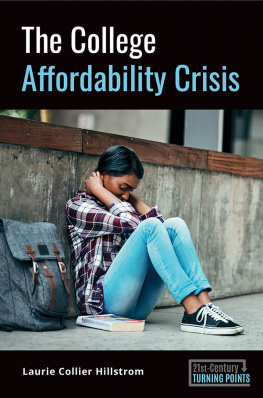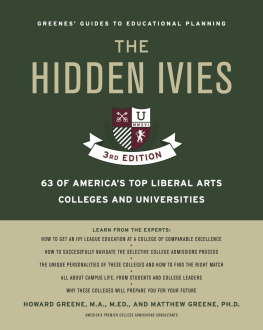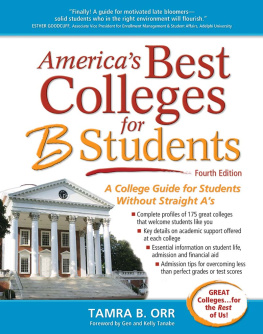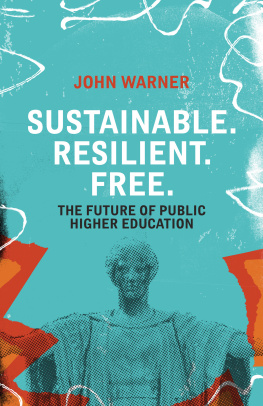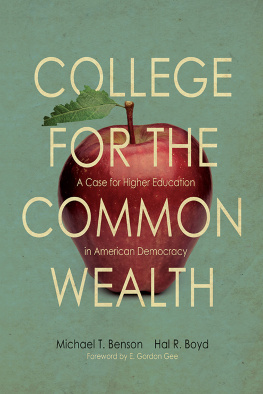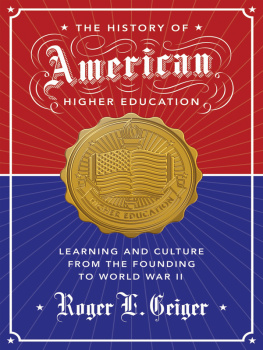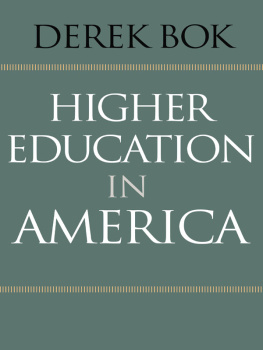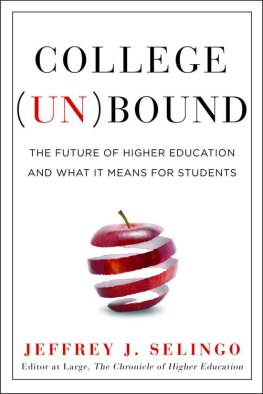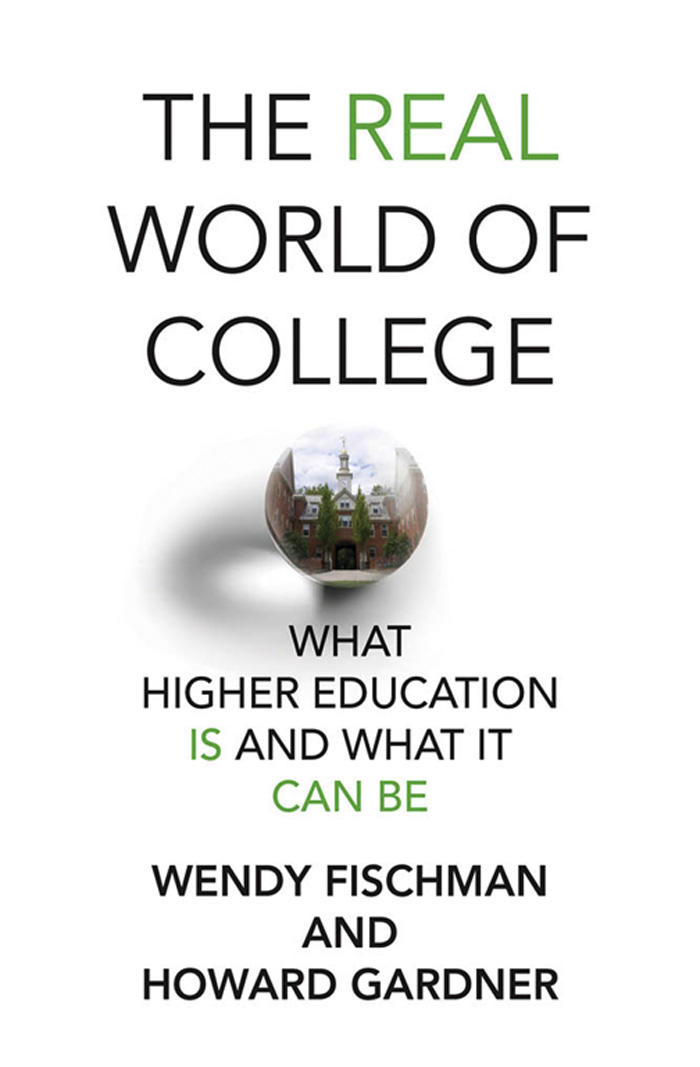
The Real World of College
The Real World of College
What Higher Education Is and What It Can Be
Wendy Fischman and Howard Gardner
The MIT Press
Cambridge, Massachusetts
London, England
2022 Wendy Fischman and Howard Gardner
All rights reserved. No part of this book may be reproduced in any form by any electronic or mechanical means (including photocopying, recording, or information storage and retrieval) without permission in writing from the publisher.
The MIT Press would like to thank the anonymous peer reviewers who provided comments on drafts of this book. The generous work of academic experts is essential for establishing the authority and quality of our publications. We acknowledge with gratitude the contributions of these otherwise uncredited readers.
This book was set in Scala and ScalaSans by New Best-set Typesetters Ltd.
Library of Congress Cataloging-in-Publication Data
Names: Fischman, Wendy, 1971 author. | Gardner, Howard, 1943 author.
Title: The real world of college : what higher education is and what it can be / Wendy Fischman and Howard Gardner.
Description: Cambridge, Massachusetts ; London, England : The MIT Press, [2022] | Includes bibliographical references.
Identifiers: LCCN 2021014609 | ISBN 9780262046534 (Hardcover)
Subjects: LCSH: Education, HumanisticUnited StatesCase studies. | Educational change. | Alienation (Social psychology) | College studentsMental healthUnited States. | College studentsPsychology.
Classification: LCC LC1011 .F475 2022 | DDC 378.1/980973dc23
LC record available at https://lccn.loc.gov/2021014609
10987654321
d_r0
May young people everywhere have the kind of education that we were fortunate to have received.
Contents
Introduction
Books about higher education in the United States appear almost daily. Typically, they focus only on a single sector or specific issue; and all too often, their claimswhether celebratory or damningare not supported sufficiently by relevant data.
In this book, we report on a study of nonvocational higher education in the United States that may be unparalleled in its ambition and scope. Along with our research team, we spent five years visiting ten disparate campuses, carrying out over two thousand intensive, semi-structured interviews. On each campus we interviewed approximately fifty incoming students and fifty graduating students, and smaller numbers of faculty, senior administrators, trustees, young alums, parents, and job recruiters. These interviewswhich typically lasted an hour or morecovered a wide swathe of the undergraduate college experience. The campuses we visited range from highly selective private schools to less selective public institutions; they differ in terms of region, demography, and declared missions. We spent the subsequent two years carrying out quantitative and qualitative data analyses on these interviews; identifying the principal findings and themes; and then (and only then) arriving at recommendations for the entire sector. Weve written over fifty blogs, given dozens of public presentations, and published several articles in scholarly and wide-circulation publications. Now, in this book, we have the opportunity to detail our findings, conclusions, and recommendations.
We ourselves benefited from a broad higher education and we have been associated with individuals and with institutions that share a belief in the value (and the values) of this form of education. This approach has been described by various phrases: liberal arts, liberal arts and sciences, general education, and core curriculum. It typically requires students to select courses from the arts and humanities, social sciences, and the natural or physical sciences; and it may well mandate a course in writing, mathematics, or coding. Training for specific jobs is not featured and may even be discouraged. Or to put it positively, in the spirit of this book, such a broad education constitutes the best possible preparation for a wide range of positions and opportunities in the society of the future.
We had hoped (and indeed had assumed) thatwhile under some threat and some criticisman appreciation of this capacious conception of higher education would nonetheless be widely shared. But in fact, while there remains much to admire in US higher education, we have concludedon the basis of our comprehensive studythat the sector has lost its way and stands in considerable peril. And this conclusion was reached well before the COVID-19 pandemic, which has proved disruptive for all institutions of higher learning, in this country and abroad, most especially for the less affluent ones.
We did not anticipate many of our findings and conclusions; we suspect that many of them will likewise come as a surprise to our readers. To begin with, more than a thousand students across disparate campuses turn out to be more similar than different; indeed, they generally use the same vocabulary and discuss the same themes, often in similar ways. Contrary to what one gathers from the press and from certain alarmist books, students are not preoccupied with political correctness, free speech issues, or the cost of college. (To be sure, we know of other studies in the last few years that suggest greater sensitivity with respect to such issues; we dont know whether this is a temporary or long-lasting phenomenon.) Instead, we find that students are worried about their GPAs and resumes. Indeed, well before the onset of the pandemic, the biggest issues with which students struggle have been mental health challenges. Notable as well is the widespread feeling on the part of many students that they (and others) dont belongfar too many students feel alienated from peers, the academic agenda, and/or the ethos of the institution as a whole. While those adults who are off campusparents, trustees, alumsacknowledge these problems, they, like a great many students, are preoccupied with issues of jobs and/or institutional reputation. In contrast, faculty and administratorsthose presumably in contact with students on a daily basishave significantly different and more aspirational ideas about the purpose(s) of college.
As we sought to understand the perspective of students and the other constituencies whom we interviewed, we developed a number of concepts that we believe are useful.
First, we introduce four ways of thinking about the experience of attending college: inertial, transactional, exploratory, and transformational. Fortunately, few of the individuals with whom we spoke saw college inertiallyonly as the next step after high school. But less happily, far too many students have a transactional view of college, and in that stance, they are customarily joined by parents, alums, and trustees. Interest in breadth of learning, having new educational experiences, and thinking of oneself and the world in new ways is limited, and is not the purpose for which most people go to college.
We also introduce a measure of the kind of analytic, synthesizing, and communication skills that we believe college should inculcate in all students. Terming it Higher Education Capital (HEDCAP, for short), we conceive of it as the ability to attend, analyze, reflect, connect, and communicate on issues of interest and importance. We analyze the factors that contribute to development of high HEDCAP, or, less happily, maintain low HEDCAP. While on the whole, more graduating students have higher HEDCAP than first-year students, in many cases the academic benefits of a college education prove difficult to demonstrate. This state of affairs should concern all who care about the strength of a sector thatso crucial to the thriving of any contemporary societyis under considerable strain.
Next page

